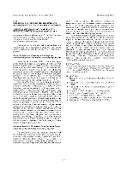Emerging Patterns of Microbiome and Resistome in The Healthcare Environment

Autor
Datum vydání
2022Publikováno v
Czech Chemical Society Symposium SeriesRočník / Číslo vydání
20 (6)ISBN / ISSN
ISSN: 2336-7202Informace o financování
MSM//LX22NPO5103
Metadata
Zobrazit celý záznamKolekce
Abstrakt
The project led by Prof. Dřevinek at the 2nd Faculty ofMedicine has two main research objectives (see below).Active collaboration with the groups in the consortium isplanned.Research objective 1: Molecular epidemiology andantimicrobial resistance in healthcare-associated pathogensAntimicrobial resistance (AMR) is one of the biggestpublic health challenges. A rapid spread of multi- and panresistant bacteria leads to difficult-to-treat infections andhigher mortality in healthcare settings. To address this issue,Pavel Drevinek's research team initiated several nationalsurveillance studies in the Czech Republic and Slovakia withthe goal to map the epidemiology of healthcare-associatedpathogens. In addition, large sets of colistin-resistantEnterobacterales and Burkholderia cepacia complex isolateswere collected over the years during the grant projects.The aim of the project is (i) to perform the prospectivesurveillance of the currently important nosocomial pathogensin the Czech Republic and Slovakia, i.e. C. difficile, S. aureus(including methicillin-resistant) and coagulase-negativeStaphylococci, vancomycin-resistant Enterococci, andmultidrug-resistant Gram-negative bacteria with plasmidmediated resistance to the last resort antibiotics. The secondaim is (ii) to gather deeper knowledge about major clones ofantibiotic-resistant nosocomial pathogens and get insight intothe forces driving their spread by studying isolates acquiredduring the prospective surveillance and from retrospectivecollections of the team. Comparative analysis of genomes andantimicrobial resistance of acquired isolates will allow toelucidate of the specific resistance determinants and theirgenetic context (plasmid or chromosome-associated genes,mutation) and also perform a phylogenetic analysis of isolatesputting them in the local and global context of respectivepathogen epidemiology. In addition, the biofilm formationand growth rates of resistant isolates in different conditionswill be analysed as important factors influencing the clinicalsuccess of the pathogenic bacteria.Research objective 2: The human virome in human diseaseand its interaction with other exposome componentsThe modern concept of the exposome encompasses allthe multifaceted exposures acting upon the organism (themicrobiota, diet, toxicants, climate), and the response of theorganism induced by these exposures (e.g. changes in itstranscriptome, proteome, metabolome). Microbes are veryimportant exposome components, including bacteria, archaea,parasites, fungi or viruses. The technical advances inmetagenomics over the last decade enabled researchers todefine the microbial component of the exposome withreassuring accuracy, yet the knowledge is incomplete of theassociation of microbes with a great range of primarily noninfectious diseases, and gaps remain also in the definition ofwhat can be regarded as a healthy microbiome.The proposed project is a logical extension of the workson virome exploration that the laboratory under the leadershipof prof. Cinek has been conducting for over 10 years.The main objective of this part of the project is to explore thevirome in longitudinal sample collections from severaldiagnoses of medical and societal importance. The projectwill study the virome during the natural disease course, inreaction to standard treatment modalities, or to targetedinterventions in ongoing clinical trials. This will be done inthe context of other components of the microbial exposome(bacteriome, mycobiome, parasitome), with backgroundmetadata characterizing the available non-microbialexposome (diet, physical activity etc).
Klíčová slova
Molecular epidemiology, Antimicrobial resistance, human virome
Trvalý odkaz
https://hdl.handle.net/20.500.14178/1794Licence
Tento výsledek je zpřístupněn v režimu gratis open access, tj. pouze pro čtení. V souladu s § 30 zákona č. 121/2000 Sb., autorského zákona, lze plný text z repozitáře také stáhnout, případně vytisknout, ale pouze pro osobní potřebu.




